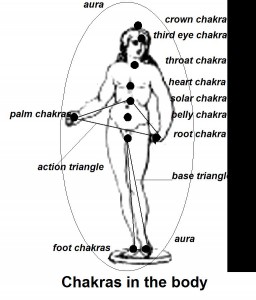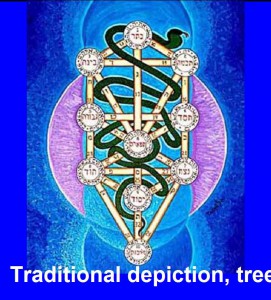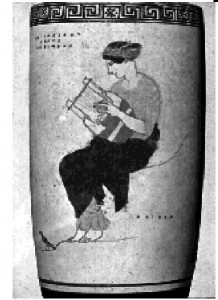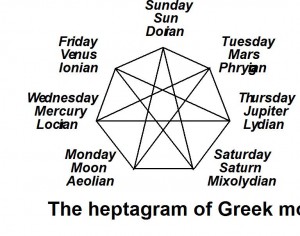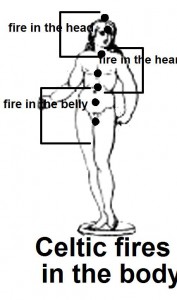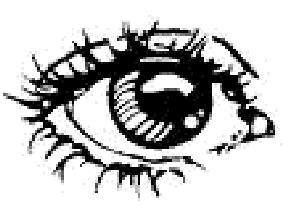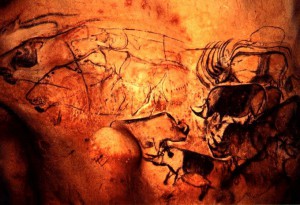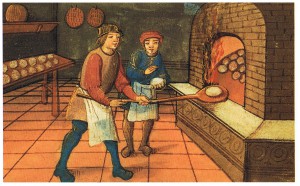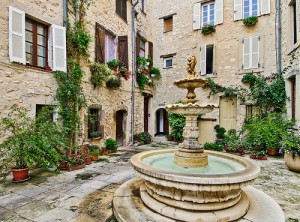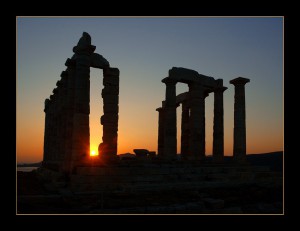Introduction to chakras
Since early in the 20th century, many Pagan and Wiccan traditions have used the Asian concept of chakras, or energy centers in the body, to expand their European traditional methods of working with healing, cleansing, protection, and empowerment. The word chakra itself comes from Hindu, like karma and many other esoteric loan-words.
The natural energies used in Wiccan practice come from our bodies, and enable us to connect with the many other natural sources of energy. Thus, it is best that we understand how our own body energies operate, and are renewed.
Here are some Wiccan-centered discussions for using chakras in your spiritual practice:
- What are chakras?
- Wheels of light—Eastern thought
- Good vibrations—Western thought
- Where elements meet—Celtic thought
- A spectrum of energies—Wiccan thought
- Tuning the spectrum—Wiccan practice
What are chakras?
The word chakra refers to a series of major and minor energy centers throughout the body. The key centers align with our glands, organs, and physiological structures. Each healthy chakra has a corresponding color and a musical pitch.
| chakra | site | organ | gland | color | pitch | rules |
| crown | top of head | brain | pituitary | violet | ti B | thought, memory |
| third eye | between the eyes | eyes & nose | pineal | indigo | la A | intuition, psi |
| throat | hollow of collarbone | ears & larynx | thyroid | blue | sol G | speech, hearing, balance |
| heart | hollow of sternum | heart & lungs | thymus | green | fa F | emotion, strength |
| solar | center of diaphragm | stomach | pancreas | yellow | mi E | energy, power |
| belly | navel | liver & kidneys | adrenals | orange | re D | digestion |
| root | base of spine | uterus & penis | gonads | red | do C | sex, birth |
| hands | palms | skill | ||||
| feet | soles | grounding |
Eastern terms
In Eastern beliefs, chakras are vital energy centers in the body. Located in the nerve ganglia along the spine, they are conceived as spinning vortices channeling cosmic energy. Blockages or interruptions of the flow of this energy is believed to cause illness, confusion, and emotional difficulty.
Wheels of light
“as if a wheel had been in the midst of a wheel.”
—Book of Ezekial
In Sanskrit, the word chakra (cakra) literally means wheel. In yoga, each chakra is perceived as a spinning wheel or sphere of energy. At its heart, the yogic system of chakras works with the following seven central chakras that align with the spine.
Many other secondary chakras exist in addition to these, in the limbs, joints, and elsewhere.
- The root chakra controls the basic functions of survival and reproduction—from involuntary responses to the sex drive.
- The belly chakra controls our energies, our power, or force, or drive—how we acquire, store, and release them.
- The solar plexus chakra controls the “base” emotions such as anger and fear—the emotional components to the fight or flight adrenaline response.
- The heart chakra controls the “higher” emotions, including love, joy, sympathy—those limbic system responses.
- The throat chakra controls creativity and self-expression—the tangible interactions with our.tribe.
- The third eye chakra controls knowledge, intuition, and perception—inner as well as outer perception, dreams as well as visions.
- The crown chakra controls access between individual human and immanent divine—and rules the aura, our energetic body.
Pairs of lesser chakras are centered in the palms of the hands and the soles of the feet. The triangle formed by the solar chakra and the two palm chakras is the action triangle, while the triangle formed by the root chakra and the two sole chakras is the base triange.
These secondary chakras are particularly used in Wiccan practice, such as in grounding, sharing energy, and healing.
Serpent energies
The movement of energy from the root through the crown chakras, called kundalini rising is held, in yoga, to trigger enlightenment. The series of energy centers in healthy balance are perceived to flow naturally through the body. One form of powerful yoga works with the polar energies of feminine and masculine—tantra yoga.
Serpents have for millennia been regarded as symbols of reincarnation and renewal. Every time they cast their skins, they leave behind an old “body” and grow brighter, more colorful (by contrast with the dulled and worn shed skin), and larger—for example, rattlesnakes gain a rattle each time they molt.
Serpents may even be related to the origin of the mythical phœnix, which regularly bursts into flames and is reborn from the ashes of its own pyre.
Serpent on the tree of life
The qabala is the Judaic mystic knowledge traditionally embedded in the diagram above, called the “tree of life.” This mysticism informs much of the post-Crusade occult studies in Western Mystery traditions. Ceremonial magic (the “high magic” of the medieval literati) derives in part from this kabballistic root. Our English word “cabal” derives from the “cabala”—one of many spellings, and refers to possessing secret knowledge; just as occult means hidden.
The ancient depiction of the kabbala, or tree of life with its several spheres, is particularly striking when compared to the previous discussion of the chakras and kundalini—serpent—energy.
| Hebrew | meaning | alchemy | concept | chakra |
| Kether | crown | Source | perfection | mind |
| Bineh Chokmah |
understandingwisdom | Saturn Zodiac |
knowledge sagacity |
vision |
| Geburah Chesed |
strength mercy |
Mars Jupiter |
might compassion |
speech |
| Tipareth | beauty | Sun | goddess | heart |
| Hod Netzach |
glory victory |
Venus Mercury |
celebration triumph |
central |
| Yesod | foundation | Moon | base | power |
| Malkuth | domain | Earth | realm | root |
Spheres on the Tree of Life (qabala)
Throughout the millennium of cabalistic application to Western magical traditions, Greek astrology and its philosophihcal cousin, medieval alchemy, were interpreted to reflect or correspond to the spheres of the tree of life. Six of these ten spheres are notably divided into left and right, male and female, polarized either side of the central “trunk” of the tree. Each of these three paired spheres correspond nicely to a single chakra, producing another example of seven central energy spheres, among which a serpent rises.
Western concepts
European philosophy is rooted in Greek thought, with their talent and skill for observing the natural world, exploring how it works, and reasoning out an understanding thereof with logic. Mechanics, music, astronomy, mathematics—all come from the minds of generations of the many Mediterranean city-dwellers that today we call Greek.
Good vibrations
“Music hath charms to soothe the savage breast.” —W. Congreve
By the 1960s, the concept of “vibrations” as a means of unspoken emotional understanding was commonplace enough to make it into the title of the Beach Boys pop hit “Good Vibrations.” Although this slang meaning uses the word metaphorically, sound waves are exactly that—vibrations of the air that move our eardrums and our brain hears as sounds: words, music, barking, waves, thunder, or wind.
Modes are the term applied to the ancient Greek system of music, in which a scale of notes uses a combination of eight whole tones and semi-tones to form one mode—in our terms, a musical scale.Greek modes
The natural call of a child for its mother is expressed around the world in a falling minor third (G–E) as they call for “mommy”; a wolf whistle spans a full octave. Sympathetic noises express themselves in descending pitch, while rising pitches are typical of excitement or joy. This natural use of pitch in human experience leads to the Greek understanding of musical modes.
The Greek mystery school taught by Pythagoreas used these seven modes to care for and cure the human spirit. History records that Pythagoreas himself once prevented a man from burning down his lover’s home—by ordering the music being played at the time into a different mode, to heal the man’s overwrought emotional state.
Our modern major and minor keys are two of patterns of the Greek seven modes. Many folk songs, rock-and-roll songs, and movie scores use others. In Western culture, the major key as is seen as cheery, the minor key as sorrowful, while many folk songs are described as plaintive or haunting.
These modes may be played in any pitch. For convenience, I list them here using keyboard notation from the white keys of a piano, to avoid the confusion of sharps or flats:
- Ionian CDEFGABC (major key. sturdy)
- Dorian DEFGABCD (folk music, sweet or sad)
- Phrygian EFGABCDE
- Lydian FGABCDEF (folk music, unearthly)
- Mixolydian GABCDEFG (folk song, lively or humorous)
- Aeolian ABCDEFGA (minor key. plaintive)
- Locrian BCDEFGAB
Each of the nine creative Muses rule one single mode, one rules all the modes, and one rules silence. Phœbus Apollo, the Greek sun god considered to be the source of logical thought, rules all the Muses; his symbol is a lyre.
The heptagram
These seven modes align with the seven planets and days of week ruled by each. These correspondences naturally lead to the Wiccan chakra alignments.
“The heptagram of Greek musical modes”
The heptagram illustrates clearly just how much the pattern of sevens has been identified by cultures across time and space. The seven-day pattern (actually a seven-night pattern, or sennight) represents a quarter of the moon’s monthly cycle, the time it takes to go from dark moon to first quarter, or full moon to last quarter.
Even the Roman calendar used two weeks, a fort[een]night, to identify the beginning, middle, and end of each month. This lunar relationship to means of counting time reflects the growing need to communicate more than the basics of “yesterday, today, and tomorrow”; or, “before, now, and after”.
Celtic thought
The Celts migrated across Europe in prehistory: the earliest known Celtic site is in Hallstadt, Austria; a later major site is in La Têne, France. Over the centuries, through this serial migration, the Celts left their imprint on the peoples with whom they lived, fought, married, and supplanted.
Where elements meet
“Can a man take fire in his bosom, and his clothes not be burned?” —Book of Proverbs
Celtic thought, like Norse thought, patterned itself in threes—the Druids and Bards, their priest–caste and lore-keepers, used patterns called triads. The Celtic worldview operates a triad of elements: earth, sea, and sky. Certainly they include fire—where the elements meet to transform the world.
Thus they name a triad of spiritual fires that transmute humankind:
- Fire in the head
- Fire in the heart
- Fire in the belly
Fire in the head
The term “fire in the head” refers to something that may be variously described as inspiration or second sight or shamanic ability. These words limit the concept, rather than explaining it, for it means all of those and more.
Instances of people remembered for their “fire in the head” may explain better:
- Archimedes; His fabled discovery of measuring a volume by measuring the water it displaces startled the exclaimation, “Eureka!” when inspiration struck.
- Joan of Arc;Inspired leader of a unifying France under a single king, she held steadfast to her vision.
- Boudicaa (Boadicea); Queen of the Iceni Celts during the Roman occupation of Britain, she led a memorable and briefly successful revolt against the Legions.
- Adolf Hitler; Charisma-created power he used for personal aggrandizement, insane phobias, and maniacal destruction.
Fire in the heart
The concept of fire in the heart reflects the intrinsic passion of a person to attempt to create a reality from a vision. This passion may be that of artists or poets or woodcarvers for their arts, or of doctors or priests or teachers for their vocations.
The reality of “mid-life crisis” often comes from an unrealized vision, as seen in the popular song:
Got a call from an old friend, We used to be real close—
Said he couldn’t go on “the American way.”
Closed the shop, sold the house, Bought a ticket to the West Coast;
Now he gives them a stand-up routine in L A
—Billy Joel
“Brotherly love” falls into this category, as does love of all non-sexual sorts—close kin, dear friends, beloved mentors, kindred spirits.
The fabled friendship between Damon and Pythias is classic: one man stood hostage for the other, who then returned to face death to save him, giving rise to wonder at their deep friendship. As initiates of Pythagoras’ mystery school, the two men were bonded as closely as are modern Wiccan coven-sibs, into “family by choice,” who are often dearer than are blood-kin.
Fire in the belly
Most frequently associated in modern times with personal drive or forcefulness, such as the concept of machismo, fire in the belly burns equally hot in all humans at times:
- standing up for one’s beliefs; Rosa Parks taking a “white” seat on a 1956 Alabama bus in defiance of unjust and unconstitutional law.
- upholding family honor; Dan Jansen skating for Olympic gold despite the death that very day of his beloved sister.
Organizations ranging from the Red Cross to Mothers Against Drunk Driving have been founded by individuals with fire in the belly.
This energy center has its negative side when out of balance:
- obsessive passion, such as seen in stalkers
- overweening hubris, common in megalomaniacs
- retaliatory vengeance, associated with gangs
Sexual love both healthy and unhealthy can be described as fire in the belly, but it is the force of the emotion, rather than the emotion itself, which places such passion under this lowest “Celtic chakra.”
Wiccan thought
The single commonest way of focusing on chakra energies is to work with them through the physical spectrum of colors of natural light. Because Wiccans use color extensively in correspondences of all sorts, this discussion focuses on the color-centric model of the chakras.
A spectrum of energies
…some gay creatures of the element,/ that in the colours of the rainbow live,/
and play…” —John Milton
The spinal chakras are most often described as corresponding to the colors that make up the visible wavelengths in the electro-magnetic spectrum:
- red (centered on 650 ångstroms [nanometers])
- orange (590 å/nm)
- yellow (570 å/nm)
- green (510 å/nm)
- blue (475 å/nm)
- indigo (445 å/nm)
- violet (400 å/nm)
These are the colors that we see in the rainbow, through a prism, or even when the sun slants through our own hair or past the edge of our noses. Because the human body is largely composed of water, every cell refracts light just as does a rain shower or a mist from a sprinkler.
The red color has the slowest frequency and longest wavelength, while the violet has the fastest frequency and shortest wavelength. The red end of the spectrum is the direction of entropy (infrared, or sub-red, energies are heat). Each visible color thus resonates with the corresponding chakra.
Red
The base or root chakra is associated with our very means of survival in many ways, from individual survival to survival of the species. Its natural color is red, the crimson and scarlet of blood. Blood is intimately associated with our drive to survive—the blood of our hunts, the blood of our enemies, the blood of our births, and the blood of our deaths.
Orange
The second chakra corresponds with the centers of self-defense, energy harvest, and power production. Its corresponding color is orange, the color of fire. The liver and kidneys defend us from toxins, the liver stores energy, and the adrenal glands tap that chemically stored energy in our bodies and make it available to us to fight or flee.
Yellow
As we move up the spectrum to yellow, we move to the third of the survival chakras, the gut and the pancreas, which control our metabolisms. The color of our sun, so crucial to our existence, corresponds to the solar (solar plexus) chakra.
The digestive system is sometimes called “the second brain.” The solar plexus is the nerve center of that brain. We have all experienced many of the decision-affecting sensations rooted in the gut: “butterflies,” heartburn, queasiness, constipation.
Green
Green is the center of the visible spectrum, largely because our sun puts out the most energy centered in those wavelengths— thus, plants evolved chlorophyll to absorb those green energies, and humans evolved the ability to distinguish visually among the widely varying colors of plant life in our environment. In the center of our bodies, the intimately intertwined heart and lung system—that great pumping engine that moves fluids and gases—resonates to those living green energies; the polar twin to the chlorophyllic life force of our world.
Blue
Whenever the sky clears during the day, we see the color blue. That color is often associated with air or wind or breath. More specifically, the blue throat chakra manages communication—the organs of communication, the ears and the larynx—and balance, that three-dimensional function which depends on our internally gyroscopic ears. Our physiological means of communication depend on the physics of sound: creating it, shaping it, hearing it. It is no wonder that the blue sky is the color of the throat chakra.
Indigo
If the sky is blue during the day, it turns indigo at twilight, when we are “between the worlds” of day and night. After the sun has set, as the first stars peep out, those deep tones speak to our inmost thoughts, evoking “mood indigo.” This response comes from our “third eye,” the pineal gland, which controls circadian rhythms, sleep cycles, and our natural navigation systems. Second sight and subtle or psychic vision— all kinds of “vision” are the focus of this chakra.
Violet
The final color is violet, the fastest frequency of visible color. The crown chakra, atop the head, is the realm of violet light: intellect, memory, thought, reason, talent, and creativity—all the abilities of our brains, our minds, our consciousnesses.
White
When all the chakras are energized and in balance, they combine to make white light. Just as the whole spectrum of light combines to make white light, so the whole spectrum of chakra energies combine in a healthy person to create a “white” aura. Auras are most often perceived as being pale and silvery, which is their basic state. Many people who see auras perceive them tinted. Even healthy people are not perfectly balanced at all times, and most people have natural variation among different energy centers. Hence, if you perceive auras in a visual sense, you may note one person has a natural gold tinge, another a blue tinge, and so on. Such variation is natural, for “seeing” auras is a metaphor, where the subtle energies are interpreted visually. Muddy colors usually indicate some kind of significant imbalance. Aura perception will vary with every individual who perceives them: some may hear tones or sounds, others perceive scents, still others feel sensations. All modes of perception are equally valid; it takes practice to learn how you perceive such energies.
Wiccan practice
What do Wiccans do with all this information? We use it to help ourselves and others. Simple meditations can help strengthen and balance our chakras. Some healers use sound, crystals, or touch as part of their treatment. Finally, old and new personal relationships can tie in to individual chakras in ways we’re not consciously aware of, so that reviewing chakra connections becomes an emotional and physical means to better psychological, physiological, and metaphysical or magical health.
Tuning the spectrum
Wiccans work with chakras in a number of ways to improve their physical, emotional, and magical well-being. This book cannot impart some techniques, such as vocalizations specific to each chakra, but the following exercise work well as from written instructions.
- balancing chakras
- reviewing chakra connections
- energizing chakras
Balancing chakras
Chakras, like wheels, are seen as spinning wheels of light. Out of balance, they may slow, affecting the systems related to each one. Also, because the chakras are interdependent, one chakra running low will stress the other chakras. Hence, the most basic of chakra exercises is balancing them.
- Select a time and place for meditation without interruption; begin in a well grounded state.
- Focus on the root chakra, with its crimson color, solid grounding, and intrinsic survival instincts.
- Once you focus your awareness, visualize the chakra glowing clearly, spinning steadily. (As you move through each step, keep all of the previous chakras spinning.)
- Move your awareness up to the energy chakra, vivid with fiery color that empowers your body.
- Next, focus on the solar chakra, bright with yellow light, enabling our internal fuel cells. Once you focus your awareness, visualize the chakra glowing clearly, spinning steadily.
- Midway, your focus moves to the emerald heart chakra, with its dual-pumping actions. Once you focus your awareness, visualize the chakra glowing clearly, spinning steadily.
- Now comes the throat chakra, sky blue with the air that enables our sound systems. Once you focus your awareness, visualize the chakra glowing clearly, spinning steadily.
- Then move to the third eye chakra, indigo focus of our many sensory centers. Once you focus your awareness, visualize the chakra glowing clearly, spinning steadily.
- At last comes the crown chakra, violet skullcap of memory, mind, and intellect. Once you focus your awareness, visualize the chakra glowing clearly, spinning steadily.
- Now that all of your chakras are spinning clear and bright, expand your awareness from the crown chakra to your entire aura, allowing it to recharge and clear with all the chakras balanced. (You may feel a strong sense of the energy rising up the column of chakras. If you do, allow this energy to rise up easily and flow into your aura, circulating like a magnetic field with the crown chakra at the “north pole” and the root chakra at the “south pole.” )
- After a few moments of aura recharge, return your awareness to the crown chakra, and allow it to relax into its natural spin rate. Keep it spinning evenly in a clear color while it “dims” from your awareness.
- Repeat the relaxation of spin with each of the remaining chakras in turn, spending with each as much time as you did coming up the series.
- When you have completed the relaxation from this exercise, use your preferred method of grounding and make sure that you are again in a well grounded state.
Reviewing chakra connections
Emotional, energetic, and magical connections are matters of interest to Wiccans for several reasons: like all magic users, each must “know thyself.” Any link may be new-grown or aged, healthy or unsound, and may connect to any chakra (or more than one). This exercise is a purposed meditative visualization for exploring the connections that you have formed, throughout your life, to others:
- through blood ties
- through friendships
- through rivalries
- through love affairs
- through hatred
- through partnerships
- through magic
Any or all of these connections may remain present long after their relevance or usefulness in your life serves any purpose. Just as you would prune the dead leaves, stems, and blossoms from a house plant, your outdated or unhealthy connections to one or more chakras need pruning, too.
- Select a substantial time for meditation without interruption; begin well grounded and relaxed, eyes closed, mentally enveloped in a silvery-gray fog, floating in comfort and ease and safety. This fog is a visualized concept of the astral plane, from which you may retreat instantly into your personal safe space, or venture forth to explore. Use this fog as your between space, moving into each chakra’s visualization in turn.
- You are in the dark, and can just see a cave mouth close by, lit by flickering firelight. As you enter, you see that the walls are extensively cave-painted in red ochre, white lime, and soot. As you move inside, you soon encounter a natural pillar of dark stone, standing before you, dominating the space.
- Explore the space, examining it for cords that connect to structure. Check each cord, how it looks, how it smells, how it seems. Old, dried, or withered cords are best cleared away, like cobwebs. Identify the object link of each cord if possible, and choose whether to retain it. Any significant unwanted cords should be severed and sealed, either now if it feels right, or in a planned future ritual or visualization. When you are satisfied with the examination of the space in this chakra, return to the gray fog, and then move on to the next chakra.
- You enter an ancient bakery built of sturdy beams, tile, and brick. On a copper-surfaced table, fresh loaves are cooling on oaken paddles. The open ovens hold coals that glow brightly as they heat the ovens anew. Examine the space for cords, check the health and desirability of each cord, deal with each as you choose, and once all are dealt with, move on through the fog.

- You move to a plaza, paved and walled in rich yellow adobe, sun-drenched and sun-baked, a space of circle dances and celebrations, surrounded by a arched and shaded colonnade, at its center a sparkling fountain bordered with black-eyed susans. Examine the space for cords, check the health and desirability of each cord, and once all are dealt with, move on through the fog.

- In a small opening within a forest, you face a snaggled stump encrusted thickly with moss. Understory shrubs form lacy walls under the sturdy boles that support the forest canopy. A green daylight warms the air, which in turn carries rich scents on a gentle breeze. Examine the space for cords, check the health and desirability of each cord, and once all are dealt with, move on through the fog.
- You hear the rich sounds of a brass choir as you near a large gazebo that shows more azure sky than it hides. Curiously, no musicians are to be seen, though the music continues bright and clear. As you step within, the music comes clearer yet within its space. Step up to the center podium and take up the peeled birch switch to lead the unseen music as it feels right. When it is time, examine the space for cords, check the health and desirability of each cord, and once all are dealt with, move on through the fog.

- A lake, of deepest ultramarine, supports a simple dory that carries you to an tiny island covered in heath, faintly blue beneath a vivid twilight sky. A bluestone henge stands tall and complete thereon; you enter the circle beneath the capstone of a dolmen. Examine the space for cords, check the health and desirability of each cord, and once all are dealt with, move on through the fog.
- You enter a simple Doric temple under a violet sky, with the glow reflected through the ground-mist rising around the columns at the façade. Within tiny oil lamps surround a reflecting pool so that the violet tinge is brightened instead of muted. Examine the space for cords, check the health and desirability of each cord, and once all are dealt with, move on through the fog.

- Now, when you return to the silvery fog, remain there and view each chakra individutally from a distance, confirming all the alterations and improvements. Once you have finished, acknowledge each chakra in turn, in reverse order—temple and henge, music and forest, plaza and bakery, and finally the cave…and move fully into the fog, floating in comfort as you transition fully into your body, sensing the surface beneath you, the temperature of the space, flexing and stretching your body before you open your eyes.
- Stand up slowly and ground completely.
- Write down any notes concerning your experiences. Especially make note of any connections that will require tending or ending with people currently involved in your life. Consider whether you need to communicate with anyone about a link past or present.
Energizing chakras
For this exercise, you need at a minimum a cleansed natural quartz crystal or water-tumbled quartz pebble. If you have a full spectrum of colored gemstones or crystals that you work with, use those, color-matched to the seven chakras—a lump of copper or bronze can substitute for an orange stone, and gold or yellow brass for a yellow one.
- Select a time and place for meditation without interruption; begin in a well grounded state. Lie flat for this exercise, legs parallel, arms alongside your body.
–Have a bowl or pan of rock salt or clean earth to set the stones on after each one is used.
–If using colored stones, lay them out in order beside you, conveniently so that you need not look at them.
–If using clear quartz, have it ready at hand, and ground the quartz to the salt (earth) between each chakra.
- Once you are lying down, ground and center once again.
- Take your red or quartz gemstone in your dominant hand. Move it to a point a few inches from your body (at aura distance) above the root chakra (roughly over the pubic and tail bone). Circle the stone widdershins (counterclockwise) over the chakra, focusing on your grounding connection so that any detritis can flow away down that connection, until the chakra feels clear; then circle the stone deosil (clockwise) to energize the chakra and seal it when it feels fully energized. (Ground quartz after each chakra.)
- Change gemstones to your orange stone if using colored stones, and move to the belly chakra (a few inches circle midway between your navel and pubes). Clear the chakra widdershins, then energize and seal the chakra deosil.
- Change gemstones to your yellow stone if using colored stones, and move to the solar chakra (a few inches circle around the pit of the stomach). Clear the chakra widdershins, then energize and seal the chakra deosil.
- Change gemstones to your green stone if using colored stones, and move to the heart chakra (a few inches circle around the hollow of the sternum). Clear the chakra widdershins, then energize and seal the chakra deosil.
- Change gemstones to your light blue stone if using colored stones, and move to the throat chakra (a few inches circle over the hollow of the throat). Clear the chakra widdershins, then energize and seal the chakra deosil.
- Change gemstones to your indigo (deep blue) stone if using colored stones, and move to the third eye chakra (a few inches circle around the bridge of the nose). Clear the chakra widdershins, then energize and seal the chakra deosil.
- Change gemstones to your violet or purple stone if using colored stones, and move to the crown chakra (a few inches circle over the top of your head). Clear the chakra widdershins, then energize and seal the chakra deosil.
- Set any stones you’re using down. Raise your hands above your head and smooth down your aura from your crown chakra to your thighs three times. The first time hold your hands a few inches away from your body, the second time barely above your clothing, and the last time making firm contact with your body.
- Stand up and ground once again; take note of any sense of excess energy in any part of your body, specifically allowing such excess to flow easily into the earth to balance you.

